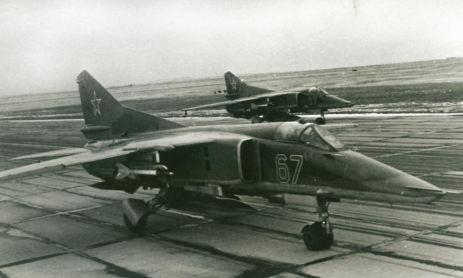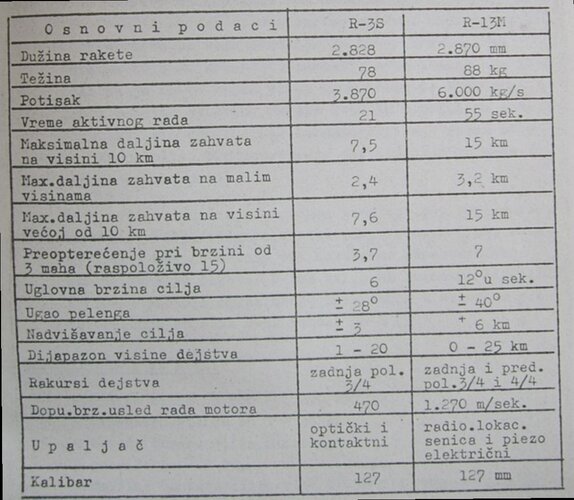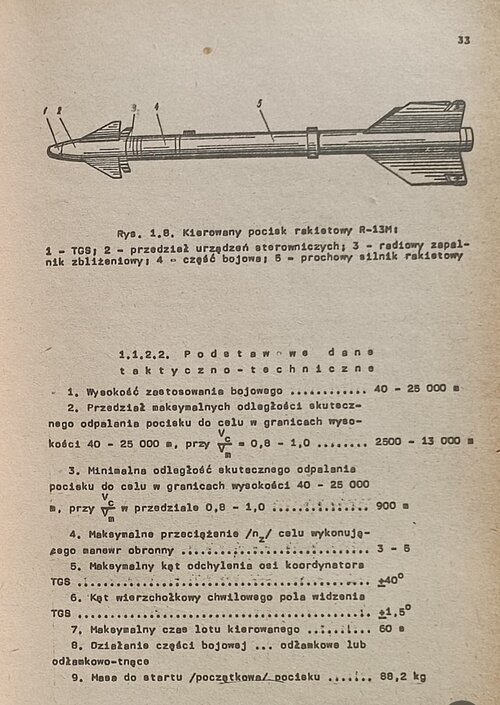Blitzer9856
ACCESS: Restricted
- Joined
- 13 August 2019
- Messages
- 48
- Reaction score
- 73

This is an obscure missile..
I am wondering, does anybody have information on its maximum body G load and tracking rate in degrees per second?
This is what I personally know (quoting myself from sources I have):
The R-13M1 is a development of the R-13M that was undergoing work even before the R-13M was introduced. Vympel began working on the R-13M's improvement already in 1973 (the R-13M was introduced in 1974) and began tests in 1975 until its introduction in late 1976. During that period, one unspecified MiG-21 version together with one MiG-21bis, two MiG-23 and one MiG-23ML launched a total of 19 telemetry and 19 combat test specimens of the R-13M1. In addition, one MiG-23 together with two MiG-23ML and one export MiG-23MS were reserved for the state examination program. Changes over the R-13M include the new canard design, which was influenced by AIM-9J examples stolen from a South Korean airbase in the early 70s. The new canards significantly increased its maneuverability, and the INEY-70 seeker of the R-13M was replaced with the INEY-M which increased the missile's view from 28° to 40°. The missile retained the 11.3 kg warhead, the DWP-240 rocket motor with a burn time of 4.5 seconds and the same flight time of 54 seconds.
In the previous R-13M missile, the tracking rate was 12°/s, the launch limitation was 3.7G and it could track targets pulling up to 5G. The R-13M1 improved on this with 6G and 7G respectively. The new, more sensitive seeker also improved its maximum seeker range from 15 km to 17 km.
However, tuning the R-13M1 into a fully eligible weapon for service was somewhat delayed. Therefore, was officially included in the VVS armament only on January 18, 1982 (together with the MiG-23ML aircraft), and was produced at the production plant No. 43 Kommunar, where it enjoyed a production run from 1977 till 1981. The missile saw limited service within the USSR, and was never exported. It was retired in 1988.
What I don't know though, and what I would really appreciate is if someone has any idea on the tracking rate of the R-13M1 and its maximum G load. For example in the air the AIM-9J could pull up to 22G, and track at 16.5°/s. Any help would be greatly appreciated!
There is also another missile in the family, which is like twice more obscure..

While work was underway on fourth generation jet fighters such as the MiG-29 and Su-27 in the late 70s, in 1974 Vympel OKB proposed yet another new missile based on the K-13 series to replace the R-13M and R-13M1 for those new jet fighters. At that time, the R-13M1 was about to enter service and was in the shadow of the R-60/R-60M. However, this did not stop them from improving on the series even more. They were considered as the cheap alternatives to more advanced missiles. The plan was to replace the R-13M1 with the K-14 / R-14, and the R-60/R-60M with the upcoming R-73 missile.
The company begun developing the new missile, while in the meantime they were also working on the R-73. Results have shown that with an increase in mass, the R-73 became all aspect and thus became a direct competitor to the R-14, threatening its future.
The R-14 was elongated enough to have caused a reduction in aerodynamic drag, but at the same time it required a higher moment of intertia and so they developed the "duck" scheme to increase its control forces for maneuvering. This was however problematic still, as the missile had limited angles of deflection for its rudders, which meant that at high AoA they lost their effectiveness due to stalling. A possible solution was the use of aerodynamic rudders on a feathered base to reduce the effective angle of attack. With this scheme, it was determined only by the rudder deflection angle, and not the sum of this value with the angle of attack of the rocket body. Despite this, the proposal of GosNIIAS, as well as another recommendation of the specialists of this institute, proposed to abandon the "pilotless" control scheme as it was not accepted by the designers of Vympel. To increase the efficiency of rudders at high angles of attack, destabilizers were used to straighten the flow.
The missile officially entered testing in 1978. A MiG-23ML no.123 was used as its carrier, and a total of five launches were made.
Despite being characteristically similar to its competitors (the R-60M and R-73), work on it was halted in favor of the more promising R-73. The program was officially concluded on the 14th of June, 1979.
No pictures of it exist. I think it would be a miracle if someone found one. It was only launched five times, from a MiG-23ML, and never entered service.
Sources used:
MiG-23: To Protect the Skies of the Motherland (Victor Markovsky)
Mikoyan-Gurevich MiG-23/27: Soviet Swing Wing Fighter/Strike Aircraft (Y. Gordon)
Mikoyan-Gurevich MiG-29: Famous Russian Aircraft (Y. Gordon)
Soviet/Russian Weapons Since WW2 (Y. Gordon)
Last edited:





